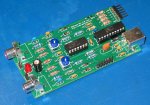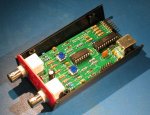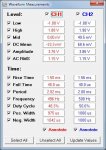Ok, I put a placeholder for the fuse in like John suggested. I used a 1206 SMT footprint - that is easy to solder even for a beginner. I was not able to find reasonable fast polyfuses in a through-hole package, while 1206 packaged ones offer down to 100 msec. If you don't care about the fuse protection there is no need to do anything. If you do, you need to cut the trace between the two SMD pads and bridge it with the polyfuse.
I also ran some quick code simulations, looks like the logic analyzer can achieve at least 500 kSamples/sec for a record length of >800 samples. That's just about sufficient to debug standard 100 kHz I2C or 115 kbaud RS-232, which is good news. At least initially triggering will be very simplistic - rising or falling edge on one selectable channel out of the four (that allows to use the "interrupt on change" feature which will guarantee very fast reaction times).
As far as source code is concerned: The PC software will have the executable freely available, but probably not the source code. This is because it shares most of its code with the original DPScope which has become a commercial product.
For the firmware I am still planning to make the HEX file available. The printed circuit board has a place for an ISP header so you can program the chip in place using a Pickit 2 or 3 programmer. That said, I suspect that only few people interested in this scope will have a suitable PIC programmer at their disposal (the Rev-Ed programmer BAS800 does not support this chip). So I will also offer the scope as a self-assembly kit with PCB and pre-programmed microcontroller. I'll keep the markup small, and since I can buy in bulk chances are it will be cheaper than anybody could get the parts for a one-off (especially considering shipping expenses for the components, and the work and expense of a self-made PCB). I'll be happy if that at least ends up covering the development expenses (only counting the $$, not my time - after all, this is fun!).







